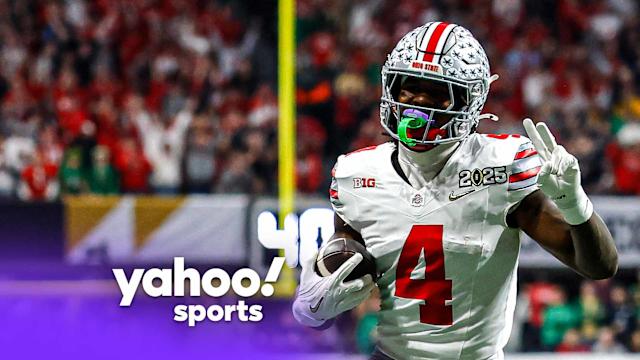
We're thrilled to announce the launch of Yahoo Fantasy guillotine-style leagues presented by Liquid Death for this season. In this killer fantasy football game, fans compete for survival every week.
We covered the basic overview for Yahoo Fantasy guillotine-style leagues in our 101 article, including a quick rundown of some of the strategies that managers should specifically consider for this format.
Now, let’s dive deeper into the approaches that can help you in your guillotine drafts and how they might differ from traditional season-long fantasy leagues.
Focus on the short-term
Guillotine-style leagues are all about surviving each week by not posting the lowest score, so your plans need to shift more towards the present.
You don’t need to worry about optimizing for the stretch run or finding that perfect late-season correlation that will get you over the hump — at least, not yet. Managers who take a long-term view for their roster on draft day are susceptible to overlooking the current slate, and one bad week can send you packing.
[Join or create a Yahoo Fantasy guillotine-style football league]
That means when you’re drafting, you should give more thought to players who could get off to hot starts, while breaking ties against those who have added risk in the opening weeks.
Maybe that causes you to select some players whom you don’t think will be able to lead you to a title, which is fine — they don’t have to. Week after week, the entire roster of the last-place team will be released to the waiver wire for everyone to bid on.
So you’ll have tons of opportunities to upgrade your lineup from the new batch of free agents who become available. There will be a time to plot your course down the stretch, but you have to get there first.
Remember, as long as you finish anywhere other than the bottom of your league in a given week, you stay alive to play another day. Keep your focus on the present and keep your team in the hunt for a championship — one week at a time.
Favor high-floor players
In normal redraft formats, the benefits of chasing upside are obvious and you should be thinking about that every time you’re on the clock. For guillotine-style leagues, that upside can still help you win a title, but there’s safety in finding players with high floors who can give you steady production — especially early in the season.
When your only goal is to beat the lowest-scoring team each week, volatile fantasy producers can be dangerous to put in your lineup due to the potential downside. In the first month, there will be teams eliminated simply because one or two of their early picks had a bad performance.
Drafting competent starting options who might not be league-winners but have locked in volume and aren’t at risk of tanking your team is a solid strategy.
For example, having an elite quarterback is great in regular leagues, but in guillotine it’s not as important to secure one in the draft. That’s because it’s a one-off position with a deep group to choose from. I could make a solid argument for 20-plus QBs having a path to finish inside the top-12 this year. And since you only need to prevent your team from finishing last, you can certainly get by with a solid QB2 as your starter in the opening weeks.
This also allows you to spend those early-round picks on the more premium positions of RB and WR, where you have to start multiple players.
Pursue receivers with guaranteed volume, running backs with clear opportunity for touches and high-end tight ends who earn plenty of targets.
Though you might not be used to this sort of approach, trusting stable, high-floor veterans can be the difference between advancing or going home near the start of the season.
Consider early-season schedules
You never want to get too ahead of yourself with fantasy strength of schedule, because so much can change over the course of an NFL season. That’s why I recommend using my season-long SOS matrix as a tiebreaker and not the main reason why you’re drafting a player.
But no matter what type of fantasy draft you’re participating in, being aware of the September strength of schedule for the players you’re targeting can help you gain an advantage.
Having some, most or all of your lineup going against easier opponents at the start of the season can propel you to a winning record and put you in the driver’s seat heading into October.
This is even more important in guillotine-style leagues.
Players with easier early-season slates can allow you to cruise through the first few weeks without putting your team in harm’s way.
Conversely, a star with a difficult string of early-season matchups needs to be treated with more caution in guillotine. If a player gets off to a slow start due to tough opponents in typical redraft leagues, you can overcome a loss or two and rebound as the season progresses.
Unfortunately, in guillotine-style leagues, you don’t have that luxury. The end of your season could occur at any moment and taking a chance on players facing a higher degree of difficulty in the early going is a hazard you can avoid.
Be mindful of bye weeks
In guillotine-style leagues, bye weeks take on much more importance because they’re often the reason many teams get eliminated — so you must plan ahead.
Early bye weeks can be particularly troublesome to navigate if you don’t factor them into your build during the draft.
That doesn’t mean you need to completely steer clear of players with byes in the first half of the season, but it does decrease their value in this format. Not rostering too many of them can help you avoid an early-season lineup crunch and prevent headaches when it comes to your in-season team management.
The last thing you want is to be forced to spend a big part of your budget covering for bye weeks.
Drafting players with the same bye in the second half of the year is also not ideal, but you’ll have plenty of time to reconfigure your roster before those problem weeks arrive.
Weeks 5, 8, 9, 10, 12 and 14 are the biggest concerns since they all feature at least four NFL clubs on bye.
You might not be used to checking bye weeks before drafting a player, but in guillotine, you shouldn’t draft one without knowing which week they’ll be on vacation.
Beware of risky players
Rolling the dice on players with uncertain outlooks can be a winning move in redraft formats. That’s not necessarily the case in guillotine-style leagues.
Weighing the risk and reward for players with red flags is a much more dangerous proposition when the low score is eliminated from the league every week.
We also have to throw a wide net to cover the different types of risky players you should be thinking twice about drafting.
This could include (but isn’t limited to):
Injured players who might miss the start of the season or be playing at least than 100% when they return.
Older players who might be on the verge of swift decline.
Late-round or undrafted rookies who might take a while to earn a role in the pros.
Players with off-field issues who might be facing punishment from the league.
Distancing yourself from risk at the start of the season tends to be the best approach in guillotine.
And if their situations improve as the season progresses, you’ll likely have a chance to acquire them off the waiver wire at some point.
Other strategies to consider
Fill out your starting roster early in the draft
In normal fantasy drafts, you can be selective about building your lineup and often waiting on a position can be advantageous if you can find a late-round starter. However, since we’re trying to avoid an early-season exit in guillotine-style leagues, there’s very little reason to delay drafting your starting lineup.
Be on the lookout for injury replacements
Some players will see more opportunity early in the season when starters on their team are injured. So make sure you’re up to date on players who could miss time and keep track of which backups will get more snaps in their absence.
Stacking is more risky in this format
One bad week can remove you from contending for a title. So, if you’re rostering a quarterback plus his top pass-catcher(s) and they have a down game for whatever reason, you might struggle to get by.
Grab insurance for your RBs
Insulate your star RBs with their real-life backups to prevent your lineup from getting destroyed if an injury strikes. Whenever you draft a running back in the early rounds, you should make a note of who their backup is so you can consider them later.








Comments